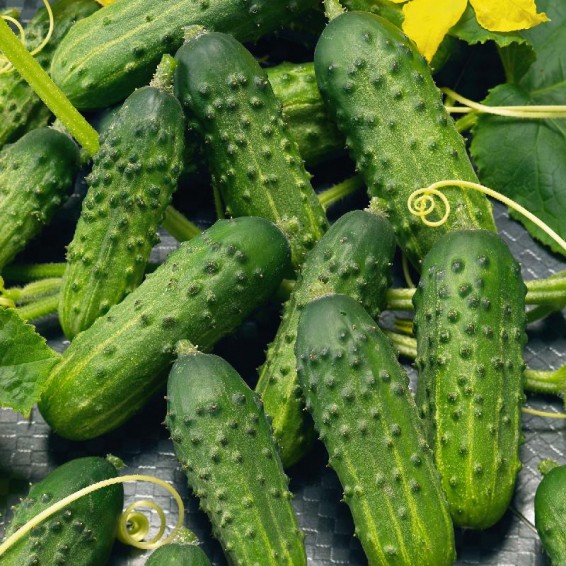Calypso Hybrid Cucumber Seeds
- HOW TO GROW
- FAST FACTS
- REVIEWS
HOW TO GROW
Sowing: Calypso pickling cucumbers do not take well to transplanting, so either start them early in peat pots or plant them directly. Start calypso pickling cucumber seeds indoors about 2 weeks before frost, placing 3-4 seeds 1/2" deep in the pot. Keep the air temperature at least 80 degrees F. When two or three leaves appear on each plant, cut off all but the strongest plant with a scissors. Before planting them, "harden" the seedlings by setting them outside during the day. Calypso pickling cucumber seeds should be planted no sooner than a week after the last spring frost, when the air temperatures consistently average 65-75 degrees F. For planting them in a hill, place three seedlings or 7-8 seeds in each hill; space hills 4-5' apart. If rows are preferable, plant seedlings 1' apart or place 5 seeds within 1' and later thin them. Cucumbers love heat and cannot endure even a light frost; if cold temperatures threaten, cover the seedlings. Since cucumbers love to climb, providing a trellis will save space in your garden and produce straighter cucumbers that are easier to pick; however, the vines will simply spread out over the ground if no trellis is provided. Some gardeners plant their cucumbers with corn, since the two plants benefit each other and the cucumbers will climb the corn. Planting several radishes with cucumbers seems to repel damaging cucumber beetles; however, cucumbers do not like being planted near potatoes or aromatic herbs.
Growing: Calypso cucumber plants tend to be rather compact in their growth and very disease resistant. Moisture is the key to growing excellent cucumbers; keep the soil consistently moist. When the vines have developed, apply mulch or straw to conserve moisture and control weeds. Watch out for cucumber beetles, and remove them immediately to prevent damage.
Harvesting: This dark green variety of cucumber works very well for pickling, though excellent as well for fresh eating at a bigger size. If picked consistently all season, the yield will be very high. When the blossom end of the cucumber begins to turn yellow, this indicates that the cucumber has passed its prime. Cucumbers store very well in the refrigerator.
Seed Saving: Because this variety of cucumber is a hybrid, the seed it produces will either be sterile or will revert to the characteristics to one of the parent seeds; reproducing this type from its own seed will not be successful.
FAST FACTS
Latin Name: Cucumis sativus
Type: Hybrid, Warm Season
USDA Zones: 3, 4, 5, 6, 7, 8, 9, 10, 11, 12
Seeds per Ounce: 1,000
Planting Method: Direct Sow
Sunlight: Full Sun
Height: 12 Inches
Color: Green
Seeds
I wish I can give 10 stars!!! Seeds are all growing very good, packing it's absolutely gorgeous . Thank you
DESCRIPTION
HOW TO GROW
Sowing: Calypso pickling cucumbers do not take well to transplanting, so either start them early in peat pots or plant them directly. Start calypso pickling cucumber seeds indoors about 2 weeks before frost, placing 3-4 seeds 1/2" deep in the pot. Keep the air temperature at least 80 degrees F. When two or three leaves appear on each plant, cut off all but the strongest plant with a scissors. Before planting them, "harden" the seedlings by setting them outside during the day. Calypso pickling cucumber seeds should be planted no sooner than a week after the last spring frost, when the air temperatures consistently average 65-75 degrees F. For planting them in a hill, place three seedlings or 7-8 seeds in each hill; space hills 4-5' apart. If rows are preferable, plant seedlings 1' apart or place 5 seeds within 1' and later thin them. Cucumbers love heat and cannot endure even a light frost; if cold temperatures threaten, cover the seedlings. Since cucumbers love to climb, providing a trellis will save space in your garden and produce straighter cucumbers that are easier to pick; however, the vines will simply spread out over the ground if no trellis is provided. Some gardeners plant their cucumbers with corn, since the two plants benefit each other and the cucumbers will climb the corn. Planting several radishes with cucumbers seems to repel damaging cucumber beetles; however, cucumbers do not like being planted near potatoes or aromatic herbs.
Growing: Calypso cucumber plants tend to be rather compact in their growth and very disease resistant. Moisture is the key to growing excellent cucumbers; keep the soil consistently moist. When the vines have developed, apply mulch or straw to conserve moisture and control weeds. Watch out for cucumber beetles, and remove them immediately to prevent damage.
Harvesting: This dark green variety of cucumber works very well for pickling, though excellent as well for fresh eating at a bigger size. If picked consistently all season, the yield will be very high. When the blossom end of the cucumber begins to turn yellow, this indicates that the cucumber has passed its prime. Cucumbers store very well in the refrigerator.
Seed Saving: Because this variety of cucumber is a hybrid, the seed it produces will either be sterile or will revert to the characteristics to one of the parent seeds; reproducing this type from its own seed will not be successful.
FAST FACTS
Latin Name: Cucumis sativus
Type: Hybrid, Warm Season
USDA Zones: 3, 4, 5, 6, 7, 8, 9, 10, 11, 12
Seeds per Ounce: 1,000
Planting Method: Direct Sow
Sunlight: Full Sun
Height: 12 Inches
Color: Green
Reviews
Review
Seeds
I wish I can give 10 stars!!! Seeds are all growing very good, packing it's absolutely gorgeous . Thank you





